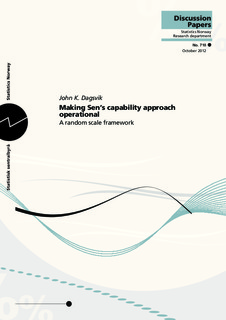| dc.contributor.author | Dagsvik, John K. | |
| dc.coverage.spatial | Norway | nb_NO |
| dc.date.accessioned | 2019-11-13T08:54:31Z | |
| dc.date.available | 2019-11-13T08:54:31Z | |
| dc.date.issued | 2012-10 | |
| dc.identifier.issn | 0809-733X | |
| dc.identifier.uri | http://hdl.handle.net/11250/2628064 | |
| dc.description.abstract | Amartya Sen has developed the so-called capability approach to meet the criticism that income alone may be insufficient as a measure of economic inequality. This is because knowledge about people’s income does not tell us what they are able to acquire with that income. For example, people with the same income may not have the same access to health and transportation services, schools and opportunities in the labor market. Recently, there has been growing interest in empirical studies based on the capability approach. Most of these, however, are only loosely related to quantitative behavioral theory, at least in a concrete and empirically operational way. The purpose of this paper is to demonstrate that the theory of random scale (utility) models (RSM) offers a powerful theoretical and empirical framework for representing and accounting for key aspects of Sen’s theory. | nb_NO |
| dc.description.sponsorship | Department of Economics, Faculty of Political Sciences, University of Turin | nb_NO |
| dc.language.iso | eng | nb_NO |
| dc.publisher | Statistisk sentralbyrå | nb_NO |
| dc.relation.ispartofseries | Discussion papers;710 | |
| dc.subject | JEL classification: C25 | nb_NO |
| dc.subject | JEL classification: C35 | nb_NO |
| dc.subject | JEL classification: D31 | nb_NO |
| dc.subject | JEL classification: D63 | nb_NO |
| dc.title | Making Sen’s capability approach operational. A random scale framework | nb_NO |
| dc.type | Working paper | nb_NO |
| dc.description.version | publishedVersion | nb_NO |
| dc.subject.nsi | VDP::Matematikk og Naturvitenskap: 400::Matematikk: 410::Statistikk: 412 | nb_NO |
| dc.source.pagenumber | 38 | nb_NO |
